Report: Sustainable Warehousing for Nestle's Supply Chain
VerifiedAdded on 2022/12/19
|26
|6025
|1
Report
AI Summary
This report provides a comprehensive analysis of sustainable warehousing practices within Nestle, a leading global food manufacturing company. It examines key aspects such as building design, warehouse layout, and operational strategies, all within the context of a Request for Quotation (ROQ) focusing on sustainability. The report emphasizes the importance of green warehousing and explores how Nestle can improve its existing digital warehousing approach by focusing on building design and layout. It includes an overview of Nestle's supply chain management, defines sustainable warehousing, and reviews relevant literature. The report also details the methodology used for data interpretation and analysis, highlighting the thematic evaluation of various proposals to support sustainable warehousing at Nestle. Finally, the report recommends best practices Nestle could adopt to enhance its sustainability efforts and overall performance. The report is written by a student and published on Desklib.
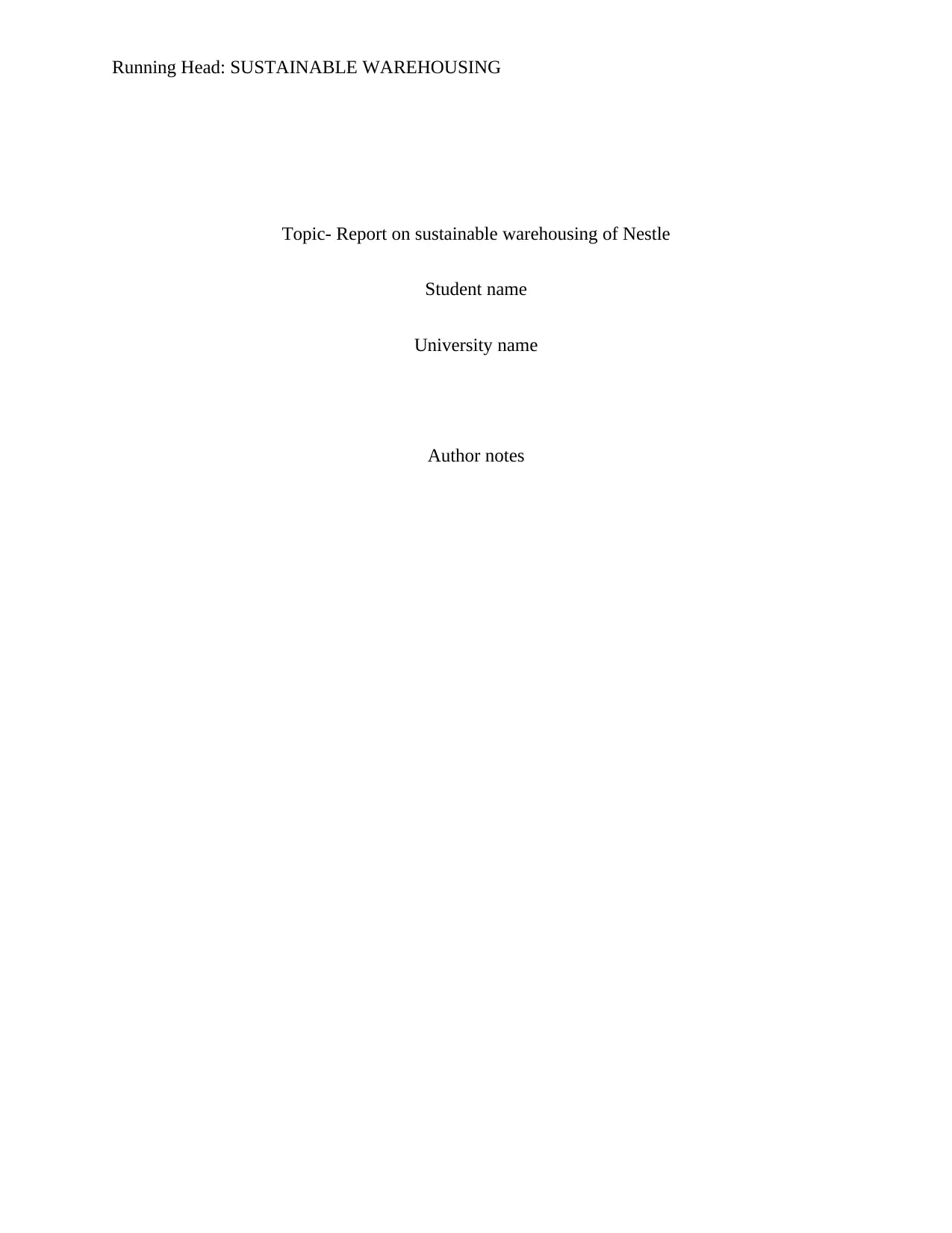
Running Head: SUSTAINABLE WAREHOUSING
Topic- Report on sustainable warehousing of Nestle
Student name
University name
Author notes
Topic- Report on sustainable warehousing of Nestle
Student name
University name
Author notes
Paraphrase This Document
Need a fresh take? Get an instant paraphrase of this document with our AI Paraphraser
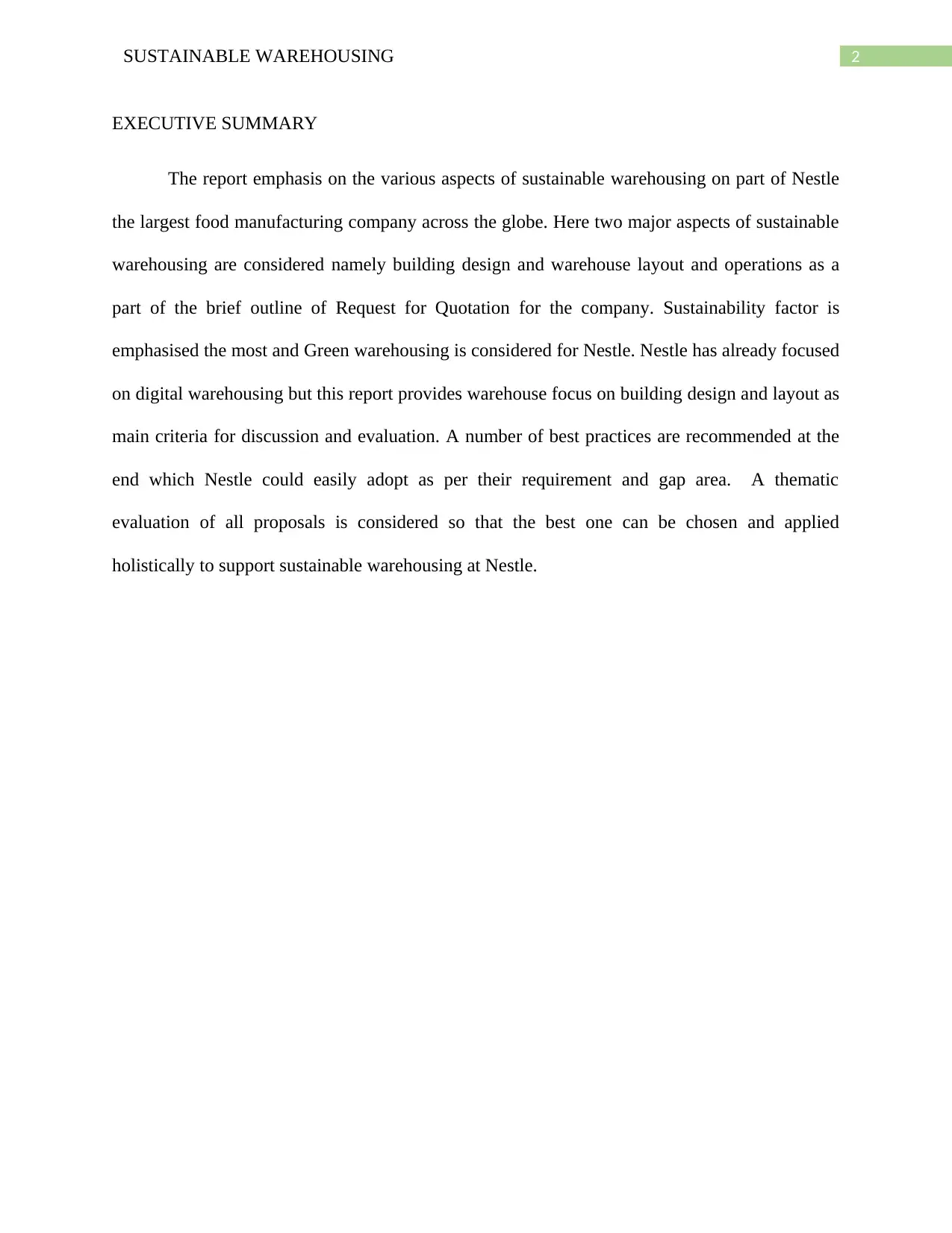
2SUSTAINABLE WAREHOUSING
EXECUTIVE SUMMARY
The report emphasis on the various aspects of sustainable warehousing on part of Nestle
the largest food manufacturing company across the globe. Here two major aspects of sustainable
warehousing are considered namely building design and warehouse layout and operations as a
part of the brief outline of Request for Quotation for the company. Sustainability factor is
emphasised the most and Green warehousing is considered for Nestle. Nestle has already focused
on digital warehousing but this report provides warehouse focus on building design and layout as
main criteria for discussion and evaluation. A number of best practices are recommended at the
end which Nestle could easily adopt as per their requirement and gap area. A thematic
evaluation of all proposals is considered so that the best one can be chosen and applied
holistically to support sustainable warehousing at Nestle.
EXECUTIVE SUMMARY
The report emphasis on the various aspects of sustainable warehousing on part of Nestle
the largest food manufacturing company across the globe. Here two major aspects of sustainable
warehousing are considered namely building design and warehouse layout and operations as a
part of the brief outline of Request for Quotation for the company. Sustainability factor is
emphasised the most and Green warehousing is considered for Nestle. Nestle has already focused
on digital warehousing but this report provides warehouse focus on building design and layout as
main criteria for discussion and evaluation. A number of best practices are recommended at the
end which Nestle could easily adopt as per their requirement and gap area. A thematic
evaluation of all proposals is considered so that the best one can be chosen and applied
holistically to support sustainable warehousing at Nestle.
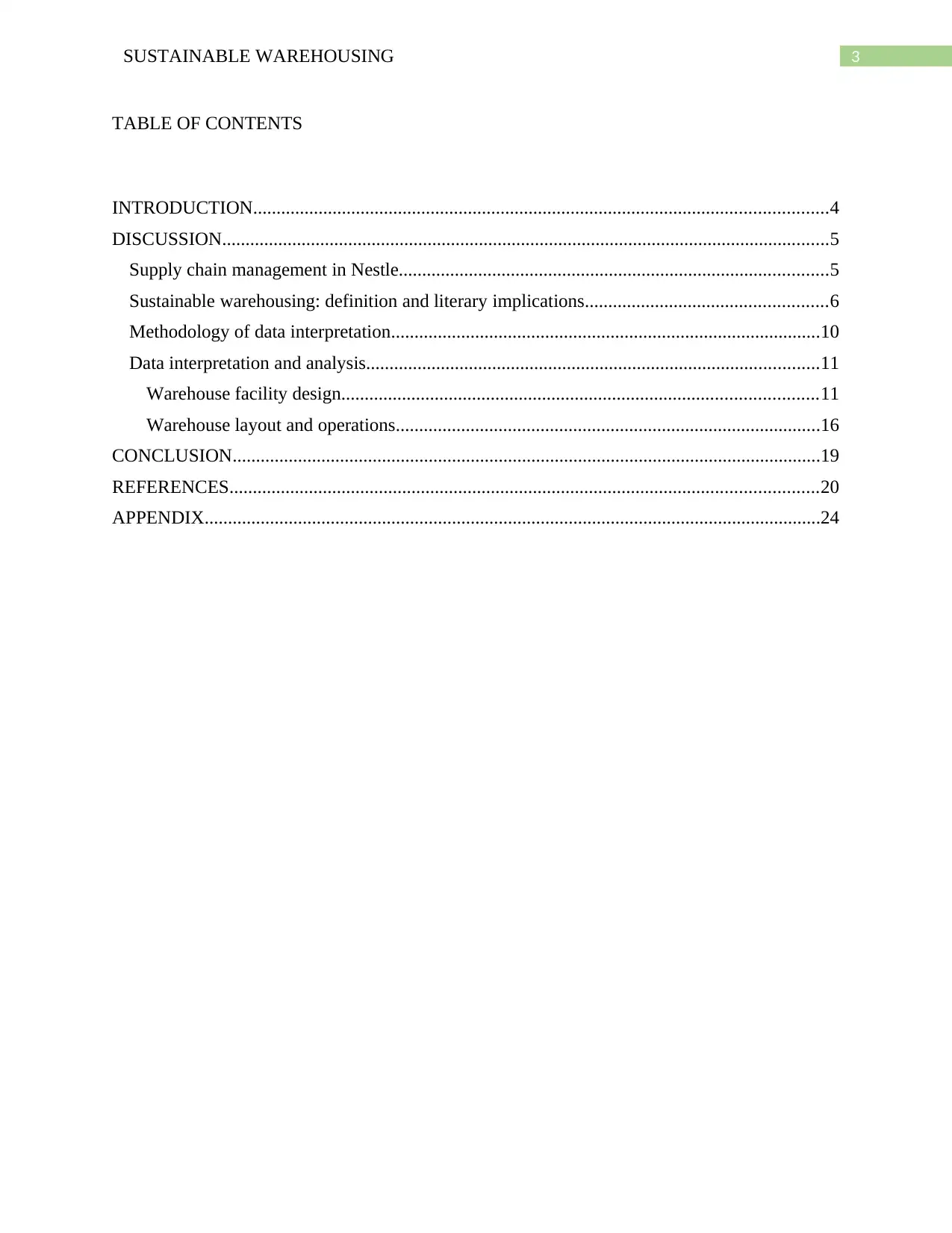
3SUSTAINABLE WAREHOUSING
TABLE OF CONTENTS
INTRODUCTION...........................................................................................................................4
DISCUSSION..................................................................................................................................5
Supply chain management in Nestle............................................................................................5
Sustainable warehousing: definition and literary implications....................................................6
Methodology of data interpretation............................................................................................10
Data interpretation and analysis.................................................................................................11
Warehouse facility design......................................................................................................11
Warehouse layout and operations...........................................................................................16
CONCLUSION..............................................................................................................................19
REFERENCES..............................................................................................................................20
APPENDIX....................................................................................................................................24
TABLE OF CONTENTS
INTRODUCTION...........................................................................................................................4
DISCUSSION..................................................................................................................................5
Supply chain management in Nestle............................................................................................5
Sustainable warehousing: definition and literary implications....................................................6
Methodology of data interpretation............................................................................................10
Data interpretation and analysis.................................................................................................11
Warehouse facility design......................................................................................................11
Warehouse layout and operations...........................................................................................16
CONCLUSION..............................................................................................................................19
REFERENCES..............................................................................................................................20
APPENDIX....................................................................................................................................24
⊘ This is a preview!⊘
Do you want full access?
Subscribe today to unlock all pages.

Trusted by 1+ million students worldwide
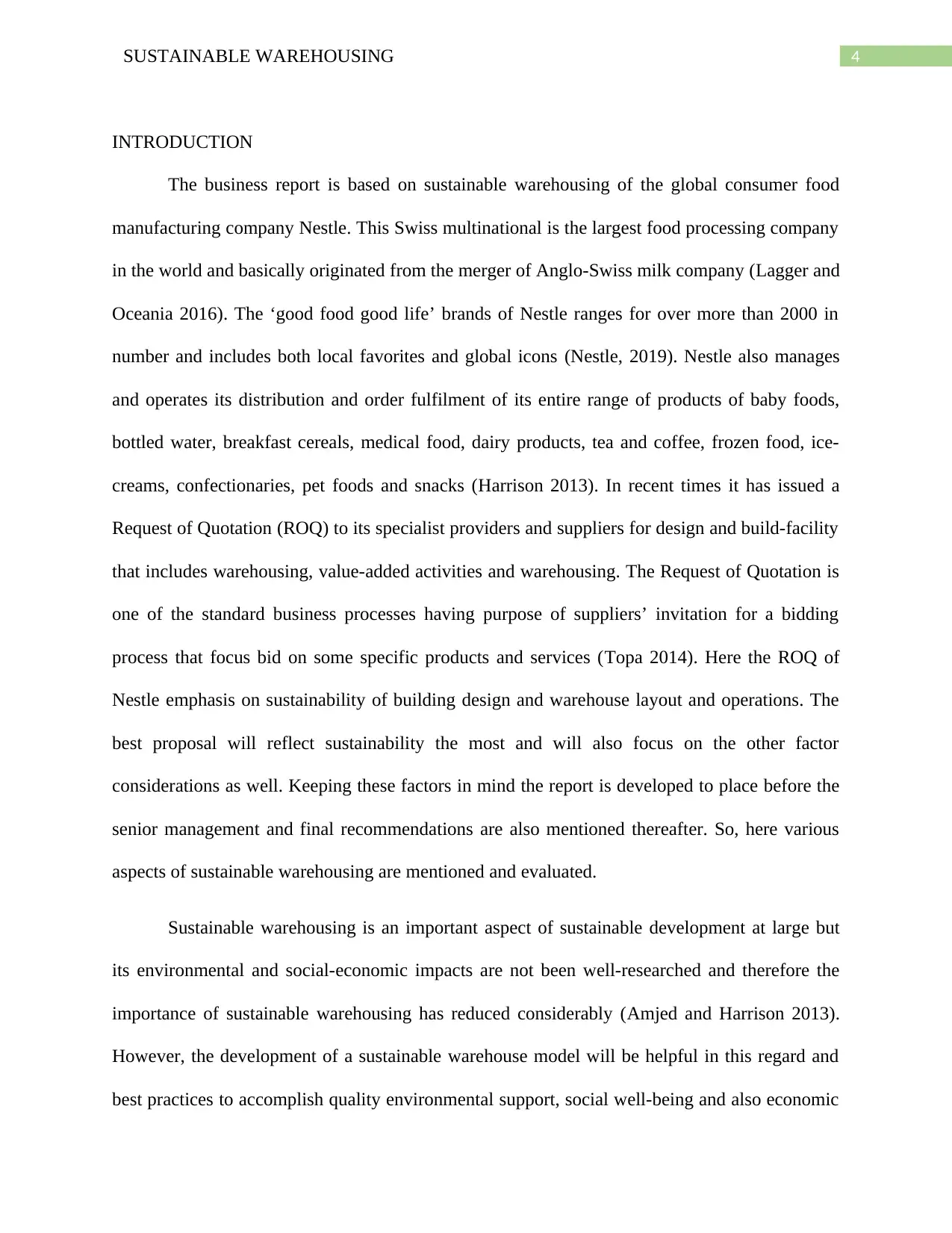
4SUSTAINABLE WAREHOUSING
INTRODUCTION
The business report is based on sustainable warehousing of the global consumer food
manufacturing company Nestle. This Swiss multinational is the largest food processing company
in the world and basically originated from the merger of Anglo-Swiss milk company (Lagger and
Oceania 2016). The ‘good food good life’ brands of Nestle ranges for over more than 2000 in
number and includes both local favorites and global icons (Nestle, 2019). Nestle also manages
and operates its distribution and order fulfilment of its entire range of products of baby foods,
bottled water, breakfast cereals, medical food, dairy products, tea and coffee, frozen food, ice-
creams, confectionaries, pet foods and snacks (Harrison 2013). In recent times it has issued a
Request of Quotation (ROQ) to its specialist providers and suppliers for design and build-facility
that includes warehousing, value-added activities and warehousing. The Request of Quotation is
one of the standard business processes having purpose of suppliers’ invitation for a bidding
process that focus bid on some specific products and services (Topa 2014). Here the ROQ of
Nestle emphasis on sustainability of building design and warehouse layout and operations. The
best proposal will reflect sustainability the most and will also focus on the other factor
considerations as well. Keeping these factors in mind the report is developed to place before the
senior management and final recommendations are also mentioned thereafter. So, here various
aspects of sustainable warehousing are mentioned and evaluated.
Sustainable warehousing is an important aspect of sustainable development at large but
its environmental and social-economic impacts are not been well-researched and therefore the
importance of sustainable warehousing has reduced considerably (Amjed and Harrison 2013).
However, the development of a sustainable warehouse model will be helpful in this regard and
best practices to accomplish quality environmental support, social well-being and also economic
INTRODUCTION
The business report is based on sustainable warehousing of the global consumer food
manufacturing company Nestle. This Swiss multinational is the largest food processing company
in the world and basically originated from the merger of Anglo-Swiss milk company (Lagger and
Oceania 2016). The ‘good food good life’ brands of Nestle ranges for over more than 2000 in
number and includes both local favorites and global icons (Nestle, 2019). Nestle also manages
and operates its distribution and order fulfilment of its entire range of products of baby foods,
bottled water, breakfast cereals, medical food, dairy products, tea and coffee, frozen food, ice-
creams, confectionaries, pet foods and snacks (Harrison 2013). In recent times it has issued a
Request of Quotation (ROQ) to its specialist providers and suppliers for design and build-facility
that includes warehousing, value-added activities and warehousing. The Request of Quotation is
one of the standard business processes having purpose of suppliers’ invitation for a bidding
process that focus bid on some specific products and services (Topa 2014). Here the ROQ of
Nestle emphasis on sustainability of building design and warehouse layout and operations. The
best proposal will reflect sustainability the most and will also focus on the other factor
considerations as well. Keeping these factors in mind the report is developed to place before the
senior management and final recommendations are also mentioned thereafter. So, here various
aspects of sustainable warehousing are mentioned and evaluated.
Sustainable warehousing is an important aspect of sustainable development at large but
its environmental and social-economic impacts are not been well-researched and therefore the
importance of sustainable warehousing has reduced considerably (Amjed and Harrison 2013).
However, the development of a sustainable warehouse model will be helpful in this regard and
best practices to accomplish quality environmental support, social well-being and also economic
Paraphrase This Document
Need a fresh take? Get an instant paraphrase of this document with our AI Paraphraser
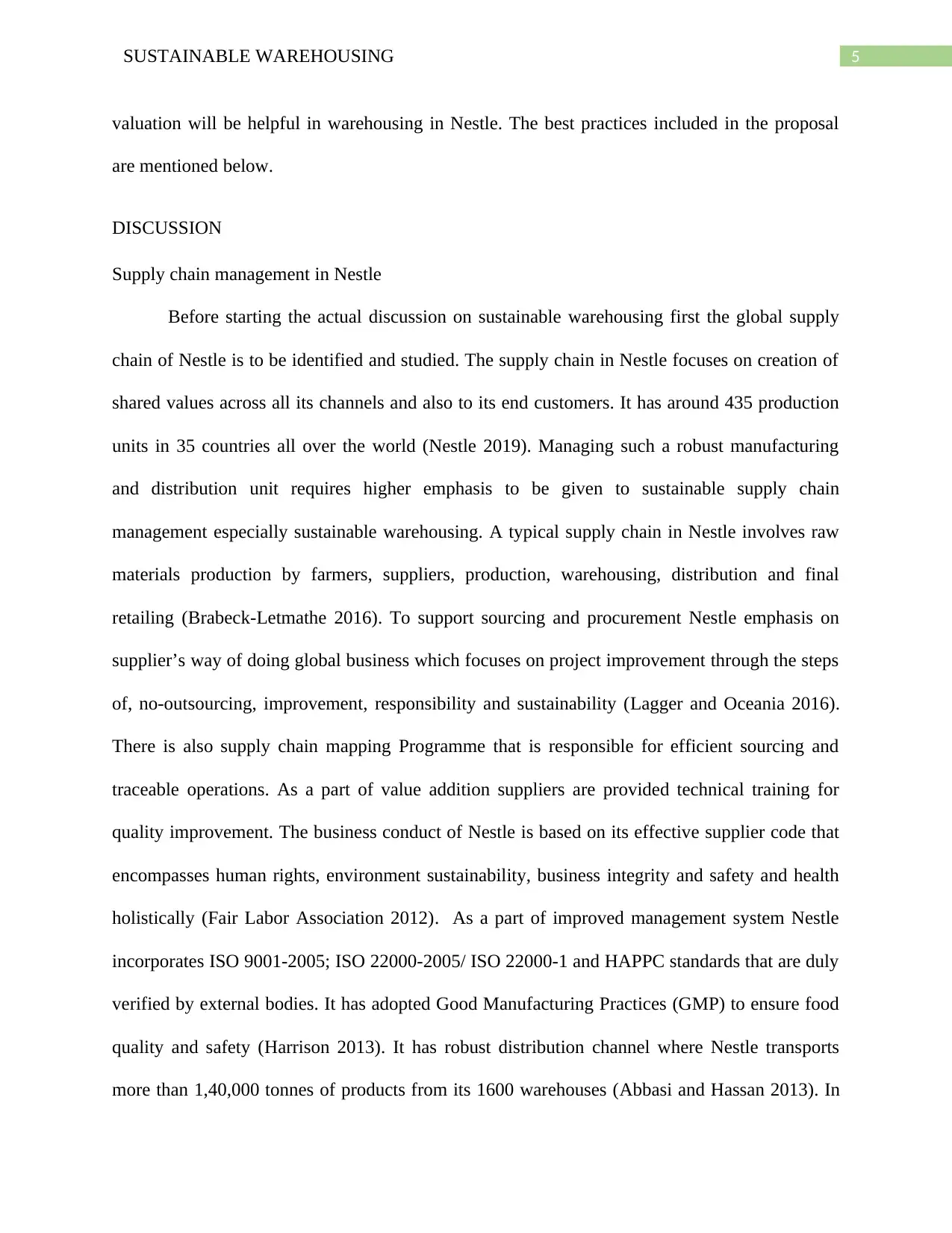
5SUSTAINABLE WAREHOUSING
valuation will be helpful in warehousing in Nestle. The best practices included in the proposal
are mentioned below.
DISCUSSION
Supply chain management in Nestle
Before starting the actual discussion on sustainable warehousing first the global supply
chain of Nestle is to be identified and studied. The supply chain in Nestle focuses on creation of
shared values across all its channels and also to its end customers. It has around 435 production
units in 35 countries all over the world (Nestle 2019). Managing such a robust manufacturing
and distribution unit requires higher emphasis to be given to sustainable supply chain
management especially sustainable warehousing. A typical supply chain in Nestle involves raw
materials production by farmers, suppliers, production, warehousing, distribution and final
retailing (Brabeck-Letmathe 2016). To support sourcing and procurement Nestle emphasis on
supplier’s way of doing global business which focuses on project improvement through the steps
of, no-outsourcing, improvement, responsibility and sustainability (Lagger and Oceania 2016).
There is also supply chain mapping Programme that is responsible for efficient sourcing and
traceable operations. As a part of value addition suppliers are provided technical training for
quality improvement. The business conduct of Nestle is based on its effective supplier code that
encompasses human rights, environment sustainability, business integrity and safety and health
holistically (Fair Labor Association 2012). As a part of improved management system Nestle
incorporates ISO 9001-2005; ISO 22000-2005/ ISO 22000-1 and HAPPC standards that are duly
verified by external bodies. It has adopted Good Manufacturing Practices (GMP) to ensure food
quality and safety (Harrison 2013). It has robust distribution channel where Nestle transports
more than 1,40,000 tonnes of products from its 1600 warehouses (Abbasi and Hassan 2013). In
valuation will be helpful in warehousing in Nestle. The best practices included in the proposal
are mentioned below.
DISCUSSION
Supply chain management in Nestle
Before starting the actual discussion on sustainable warehousing first the global supply
chain of Nestle is to be identified and studied. The supply chain in Nestle focuses on creation of
shared values across all its channels and also to its end customers. It has around 435 production
units in 35 countries all over the world (Nestle 2019). Managing such a robust manufacturing
and distribution unit requires higher emphasis to be given to sustainable supply chain
management especially sustainable warehousing. A typical supply chain in Nestle involves raw
materials production by farmers, suppliers, production, warehousing, distribution and final
retailing (Brabeck-Letmathe 2016). To support sourcing and procurement Nestle emphasis on
supplier’s way of doing global business which focuses on project improvement through the steps
of, no-outsourcing, improvement, responsibility and sustainability (Lagger and Oceania 2016).
There is also supply chain mapping Programme that is responsible for efficient sourcing and
traceable operations. As a part of value addition suppliers are provided technical training for
quality improvement. The business conduct of Nestle is based on its effective supplier code that
encompasses human rights, environment sustainability, business integrity and safety and health
holistically (Fair Labor Association 2012). As a part of improved management system Nestle
incorporates ISO 9001-2005; ISO 22000-2005/ ISO 22000-1 and HAPPC standards that are duly
verified by external bodies. It has adopted Good Manufacturing Practices (GMP) to ensure food
quality and safety (Harrison 2013). It has robust distribution channel where Nestle transports
more than 1,40,000 tonnes of products from its 1600 warehouses (Abbasi and Hassan 2013). In
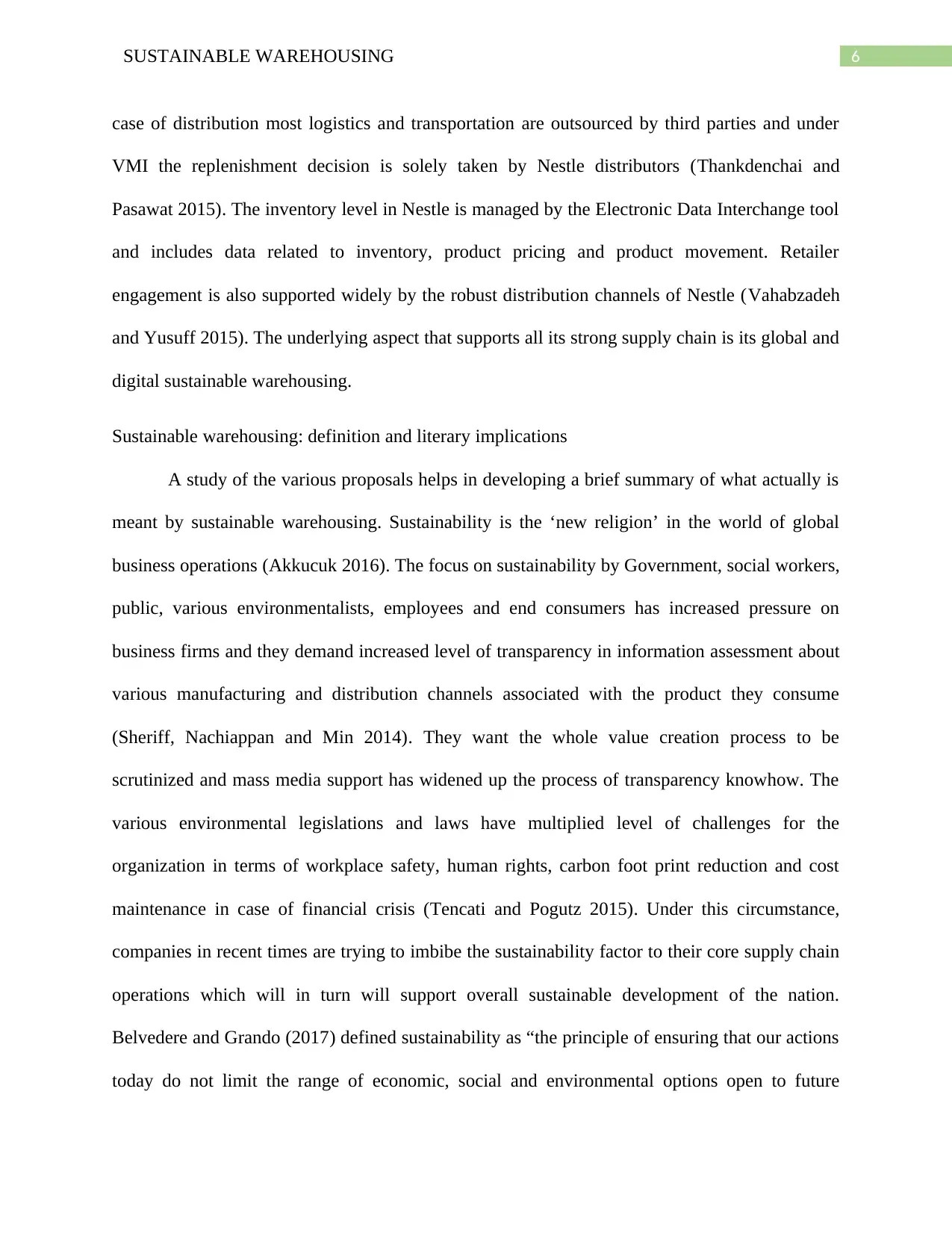
6SUSTAINABLE WAREHOUSING
case of distribution most logistics and transportation are outsourced by third parties and under
VMI the replenishment decision is solely taken by Nestle distributors (Thankdenchai and
Pasawat 2015). The inventory level in Nestle is managed by the Electronic Data Interchange tool
and includes data related to inventory, product pricing and product movement. Retailer
engagement is also supported widely by the robust distribution channels of Nestle (Vahabzadeh
and Yusuff 2015). The underlying aspect that supports all its strong supply chain is its global and
digital sustainable warehousing.
Sustainable warehousing: definition and literary implications
A study of the various proposals helps in developing a brief summary of what actually is
meant by sustainable warehousing. Sustainability is the ‘new religion’ in the world of global
business operations (Akkucuk 2016). The focus on sustainability by Government, social workers,
public, various environmentalists, employees and end consumers has increased pressure on
business firms and they demand increased level of transparency in information assessment about
various manufacturing and distribution channels associated with the product they consume
(Sheriff, Nachiappan and Min 2014). They want the whole value creation process to be
scrutinized and mass media support has widened up the process of transparency knowhow. The
various environmental legislations and laws have multiplied level of challenges for the
organization in terms of workplace safety, human rights, carbon foot print reduction and cost
maintenance in case of financial crisis (Tencati and Pogutz 2015). Under this circumstance,
companies in recent times are trying to imbibe the sustainability factor to their core supply chain
operations which will in turn will support overall sustainable development of the nation.
Belvedere and Grando (2017) defined sustainability as “the principle of ensuring that our actions
today do not limit the range of economic, social and environmental options open to future
case of distribution most logistics and transportation are outsourced by third parties and under
VMI the replenishment decision is solely taken by Nestle distributors (Thankdenchai and
Pasawat 2015). The inventory level in Nestle is managed by the Electronic Data Interchange tool
and includes data related to inventory, product pricing and product movement. Retailer
engagement is also supported widely by the robust distribution channels of Nestle (Vahabzadeh
and Yusuff 2015). The underlying aspect that supports all its strong supply chain is its global and
digital sustainable warehousing.
Sustainable warehousing: definition and literary implications
A study of the various proposals helps in developing a brief summary of what actually is
meant by sustainable warehousing. Sustainability is the ‘new religion’ in the world of global
business operations (Akkucuk 2016). The focus on sustainability by Government, social workers,
public, various environmentalists, employees and end consumers has increased pressure on
business firms and they demand increased level of transparency in information assessment about
various manufacturing and distribution channels associated with the product they consume
(Sheriff, Nachiappan and Min 2014). They want the whole value creation process to be
scrutinized and mass media support has widened up the process of transparency knowhow. The
various environmental legislations and laws have multiplied level of challenges for the
organization in terms of workplace safety, human rights, carbon foot print reduction and cost
maintenance in case of financial crisis (Tencati and Pogutz 2015). Under this circumstance,
companies in recent times are trying to imbibe the sustainability factor to their core supply chain
operations which will in turn will support overall sustainable development of the nation.
Belvedere and Grando (2017) defined sustainability as “the principle of ensuring that our actions
today do not limit the range of economic, social and environmental options open to future
⊘ This is a preview!⊘
Do you want full access?
Subscribe today to unlock all pages.

Trusted by 1+ million students worldwide
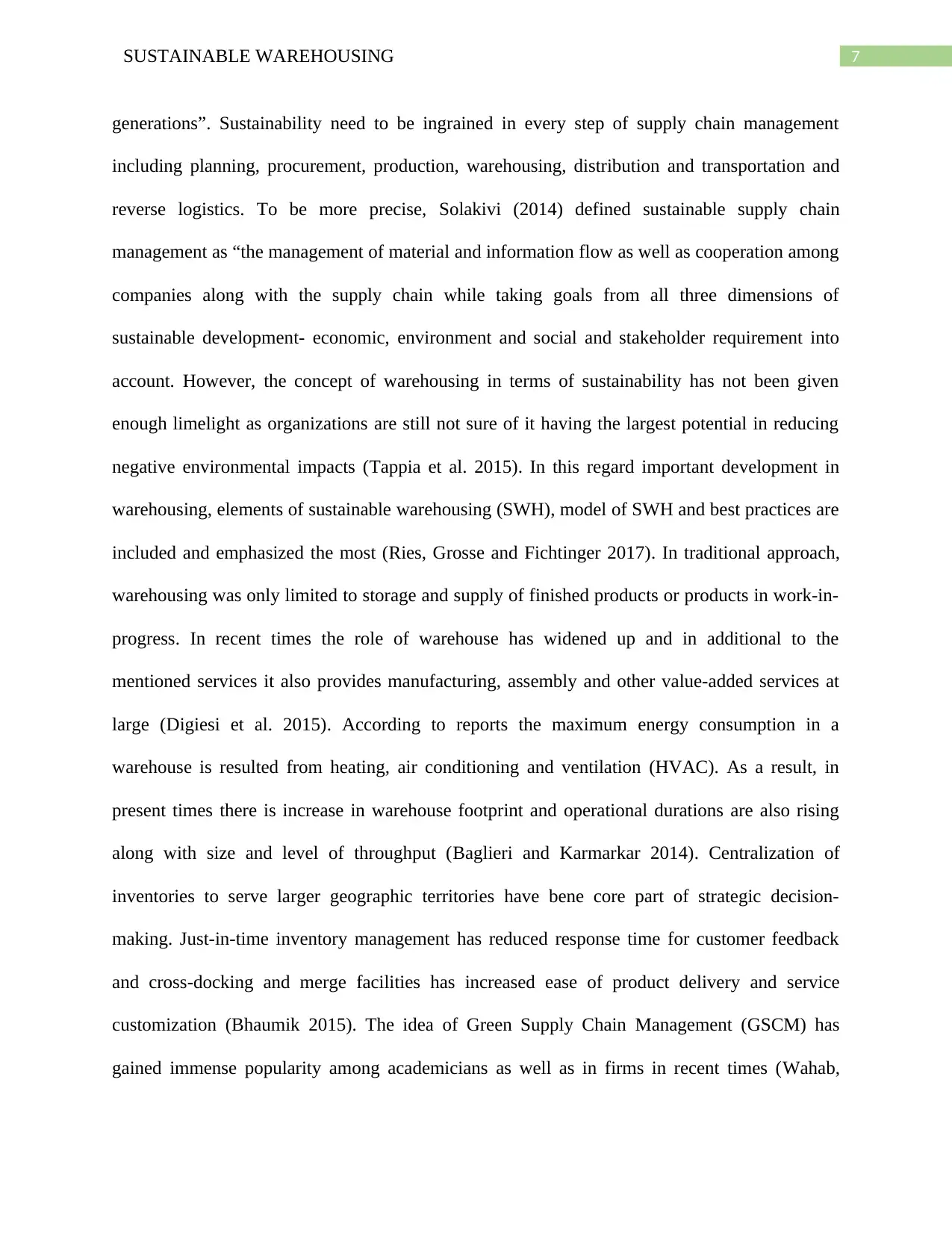
7SUSTAINABLE WAREHOUSING
generations”. Sustainability need to be ingrained in every step of supply chain management
including planning, procurement, production, warehousing, distribution and transportation and
reverse logistics. To be more precise, Solakivi (2014) defined sustainable supply chain
management as “the management of material and information flow as well as cooperation among
companies along with the supply chain while taking goals from all three dimensions of
sustainable development- economic, environment and social and stakeholder requirement into
account. However, the concept of warehousing in terms of sustainability has not been given
enough limelight as organizations are still not sure of it having the largest potential in reducing
negative environmental impacts (Tappia et al. 2015). In this regard important development in
warehousing, elements of sustainable warehousing (SWH), model of SWH and best practices are
included and emphasized the most (Ries, Grosse and Fichtinger 2017). In traditional approach,
warehousing was only limited to storage and supply of finished products or products in work-in-
progress. In recent times the role of warehouse has widened up and in additional to the
mentioned services it also provides manufacturing, assembly and other value-added services at
large (Digiesi et al. 2015). According to reports the maximum energy consumption in a
warehouse is resulted from heating, air conditioning and ventilation (HVAC). As a result, in
present times there is increase in warehouse footprint and operational durations are also rising
along with size and level of throughput (Baglieri and Karmarkar 2014). Centralization of
inventories to serve larger geographic territories have bene core part of strategic decision-
making. Just-in-time inventory management has reduced response time for customer feedback
and cross-docking and merge facilities has increased ease of product delivery and service
customization (Bhaumik 2015). The idea of Green Supply Chain Management (GSCM) has
gained immense popularity among academicians as well as in firms in recent times (Wahab,
generations”. Sustainability need to be ingrained in every step of supply chain management
including planning, procurement, production, warehousing, distribution and transportation and
reverse logistics. To be more precise, Solakivi (2014) defined sustainable supply chain
management as “the management of material and information flow as well as cooperation among
companies along with the supply chain while taking goals from all three dimensions of
sustainable development- economic, environment and social and stakeholder requirement into
account. However, the concept of warehousing in terms of sustainability has not been given
enough limelight as organizations are still not sure of it having the largest potential in reducing
negative environmental impacts (Tappia et al. 2015). In this regard important development in
warehousing, elements of sustainable warehousing (SWH), model of SWH and best practices are
included and emphasized the most (Ries, Grosse and Fichtinger 2017). In traditional approach,
warehousing was only limited to storage and supply of finished products or products in work-in-
progress. In recent times the role of warehouse has widened up and in additional to the
mentioned services it also provides manufacturing, assembly and other value-added services at
large (Digiesi et al. 2015). According to reports the maximum energy consumption in a
warehouse is resulted from heating, air conditioning and ventilation (HVAC). As a result, in
present times there is increase in warehouse footprint and operational durations are also rising
along with size and level of throughput (Baglieri and Karmarkar 2014). Centralization of
inventories to serve larger geographic territories have bene core part of strategic decision-
making. Just-in-time inventory management has reduced response time for customer feedback
and cross-docking and merge facilities has increased ease of product delivery and service
customization (Bhaumik 2015). The idea of Green Supply Chain Management (GSCM) has
gained immense popularity among academicians as well as in firms in recent times (Wahab,
Paraphrase This Document
Need a fresh take? Get an instant paraphrase of this document with our AI Paraphraser
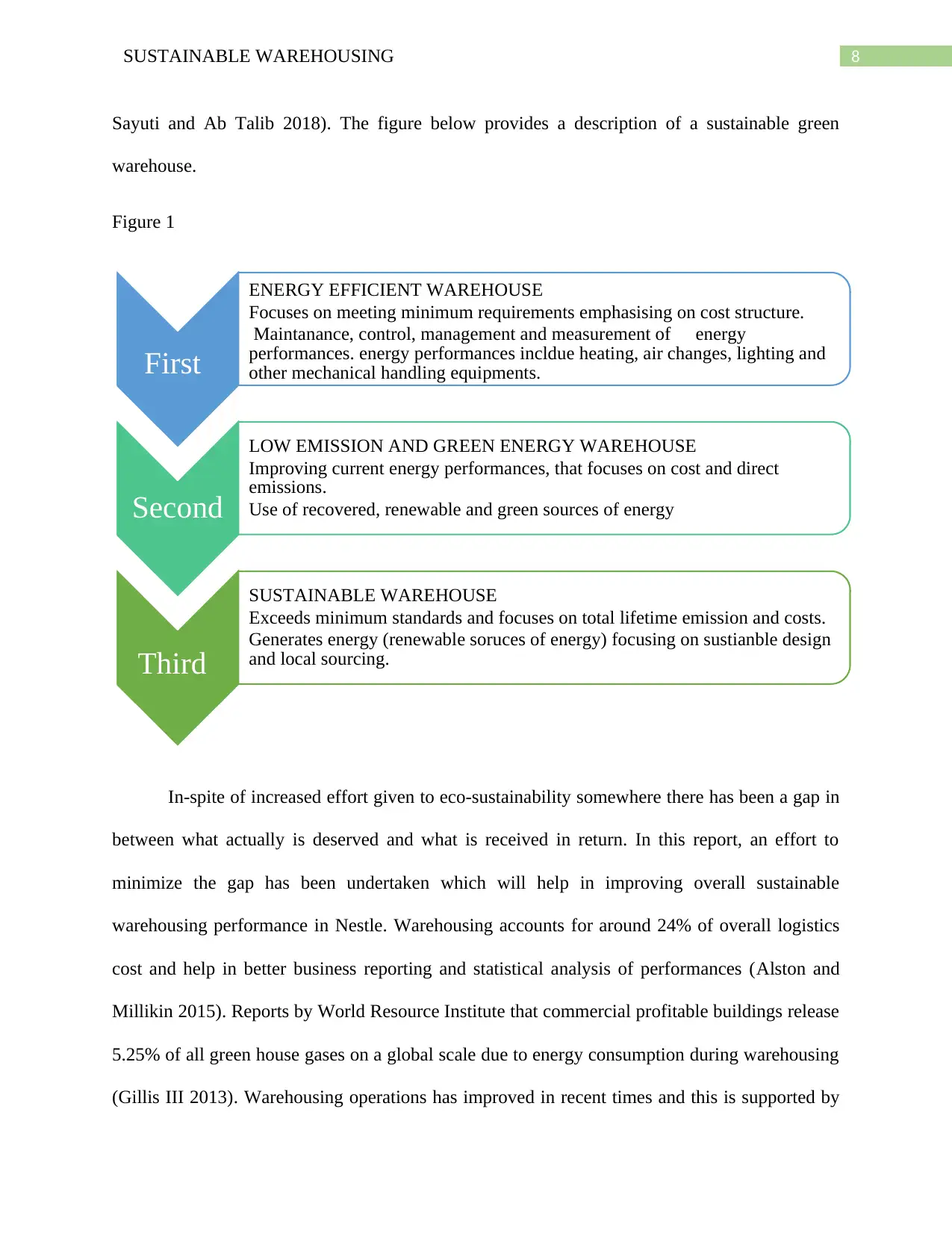
8SUSTAINABLE WAREHOUSING
Sayuti and Ab Talib 2018). The figure below provides a description of a sustainable green
warehouse.
Figure 1
In-spite of increased effort given to eco-sustainability somewhere there has been a gap in
between what actually is deserved and what is received in return. In this report, an effort to
minimize the gap has been undertaken which will help in improving overall sustainable
warehousing performance in Nestle. Warehousing accounts for around 24% of overall logistics
cost and help in better business reporting and statistical analysis of performances (Alston and
Millikin 2015). Reports by World Resource Institute that commercial profitable buildings release
5.25% of all green house gases on a global scale due to energy consumption during warehousing
(Gillis III 2013). Warehousing operations has improved in recent times and this is supported by
First
ENERGY EFFICIENT WAREHOUSE
Focuses on meeting minimum requirements emphasising on cost structure.
Maintanance, control, management and measurement of energy
performances. energy performances incldue heating, air changes, lighting and
other mechanical handling equipments.
Second
LOW EMISSION AND GREEN ENERGY WAREHOUSE
Improving current energy performances, that focuses on cost and direct
emissions.
Use of recovered, renewable and green sources of energy
Third
SUSTAINABLE WAREHOUSE
Exceeds minimum standards and focuses on total lifetime emission and costs.
Generates energy (renewable soruces of energy) focusing on sustianble design
and local sourcing.
Sayuti and Ab Talib 2018). The figure below provides a description of a sustainable green
warehouse.
Figure 1
In-spite of increased effort given to eco-sustainability somewhere there has been a gap in
between what actually is deserved and what is received in return. In this report, an effort to
minimize the gap has been undertaken which will help in improving overall sustainable
warehousing performance in Nestle. Warehousing accounts for around 24% of overall logistics
cost and help in better business reporting and statistical analysis of performances (Alston and
Millikin 2015). Reports by World Resource Institute that commercial profitable buildings release
5.25% of all green house gases on a global scale due to energy consumption during warehousing
(Gillis III 2013). Warehousing operations has improved in recent times and this is supported by
First
ENERGY EFFICIENT WAREHOUSE
Focuses on meeting minimum requirements emphasising on cost structure.
Maintanance, control, management and measurement of energy
performances. energy performances incldue heating, air changes, lighting and
other mechanical handling equipments.
Second
LOW EMISSION AND GREEN ENERGY WAREHOUSE
Improving current energy performances, that focuses on cost and direct
emissions.
Use of recovered, renewable and green sources of energy
Third
SUSTAINABLE WAREHOUSE
Exceeds minimum standards and focuses on total lifetime emission and costs.
Generates energy (renewable soruces of energy) focusing on sustianble design
and local sourcing.
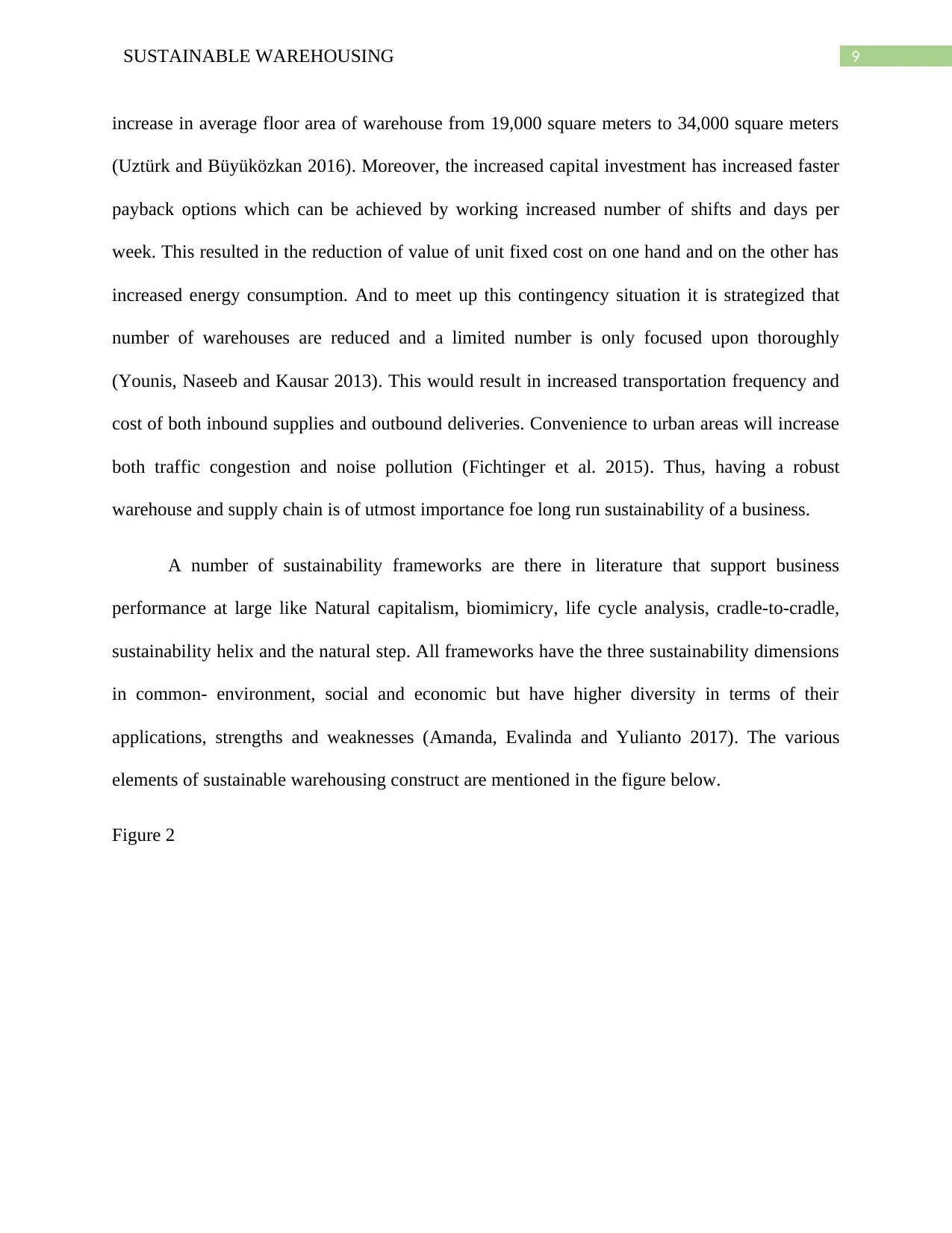
9SUSTAINABLE WAREHOUSING
increase in average floor area of warehouse from 19,000 square meters to 34,000 square meters
(Uztürk and Büyüközkan 2016). Moreover, the increased capital investment has increased faster
payback options which can be achieved by working increased number of shifts and days per
week. This resulted in the reduction of value of unit fixed cost on one hand and on the other has
increased energy consumption. And to meet up this contingency situation it is strategized that
number of warehouses are reduced and a limited number is only focused upon thoroughly
(Younis, Naseeb and Kausar 2013). This would result in increased transportation frequency and
cost of both inbound supplies and outbound deliveries. Convenience to urban areas will increase
both traffic congestion and noise pollution (Fichtinger et al. 2015). Thus, having a robust
warehouse and supply chain is of utmost importance foe long run sustainability of a business.
A number of sustainability frameworks are there in literature that support business
performance at large like Natural capitalism, biomimicry, life cycle analysis, cradle-to-cradle,
sustainability helix and the natural step. All frameworks have the three sustainability dimensions
in common- environment, social and economic but have higher diversity in terms of their
applications, strengths and weaknesses (Amanda, Evalinda and Yulianto 2017). The various
elements of sustainable warehousing construct are mentioned in the figure below.
Figure 2
increase in average floor area of warehouse from 19,000 square meters to 34,000 square meters
(Uztürk and Büyüközkan 2016). Moreover, the increased capital investment has increased faster
payback options which can be achieved by working increased number of shifts and days per
week. This resulted in the reduction of value of unit fixed cost on one hand and on the other has
increased energy consumption. And to meet up this contingency situation it is strategized that
number of warehouses are reduced and a limited number is only focused upon thoroughly
(Younis, Naseeb and Kausar 2013). This would result in increased transportation frequency and
cost of both inbound supplies and outbound deliveries. Convenience to urban areas will increase
both traffic congestion and noise pollution (Fichtinger et al. 2015). Thus, having a robust
warehouse and supply chain is of utmost importance foe long run sustainability of a business.
A number of sustainability frameworks are there in literature that support business
performance at large like Natural capitalism, biomimicry, life cycle analysis, cradle-to-cradle,
sustainability helix and the natural step. All frameworks have the three sustainability dimensions
in common- environment, social and economic but have higher diversity in terms of their
applications, strengths and weaknesses (Amanda, Evalinda and Yulianto 2017). The various
elements of sustainable warehousing construct are mentioned in the figure below.
Figure 2
⊘ This is a preview!⊘
Do you want full access?
Subscribe today to unlock all pages.

Trusted by 1+ million students worldwide
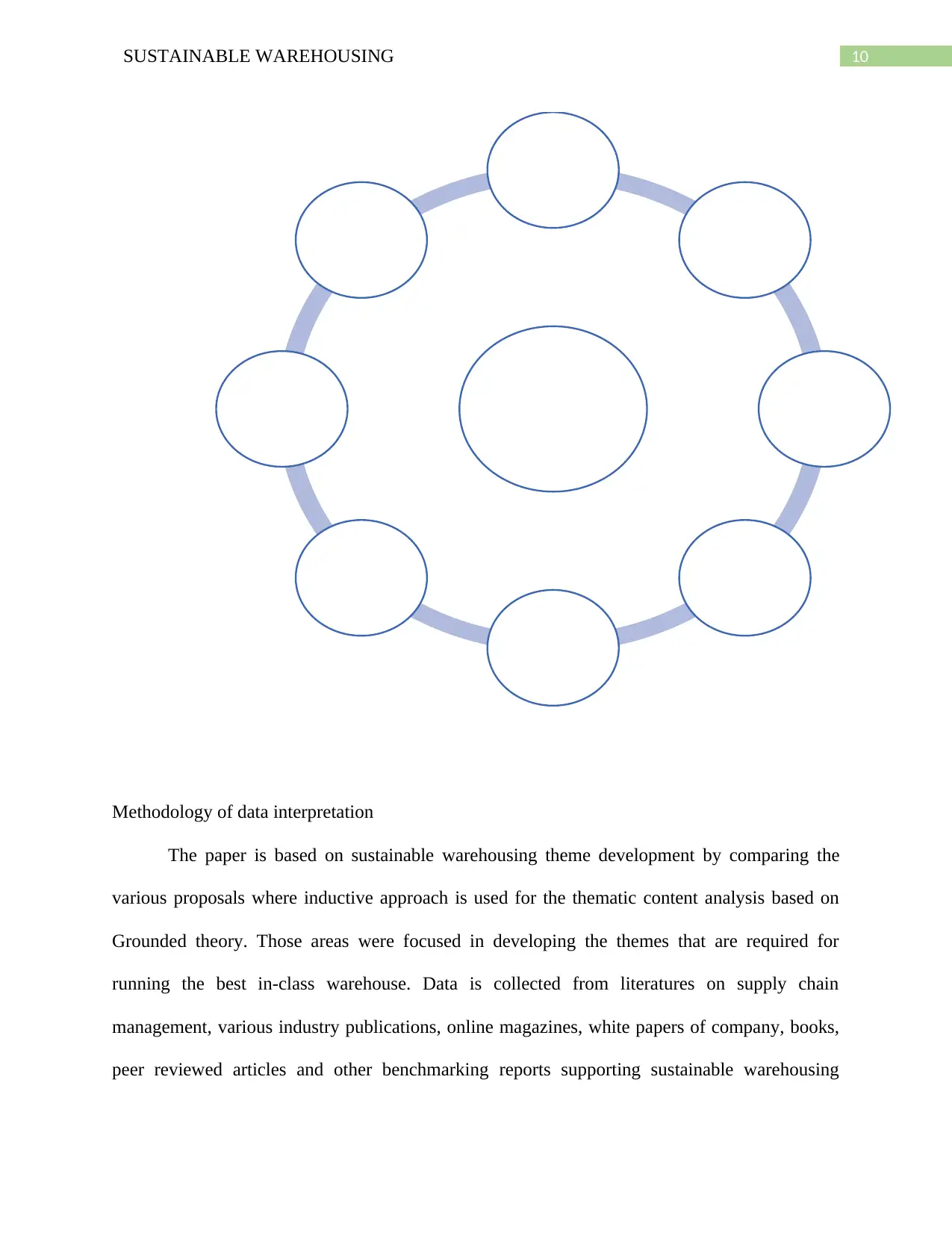
10SUSTAINABLE WAREHOUSING
Methodology of data interpretation
The paper is based on sustainable warehousing theme development by comparing the
various proposals where inductive approach is used for the thematic content analysis based on
Grounded theory. Those areas were focused in developing the themes that are required for
running the best in-class warehouse. Data is collected from literatures on supply chain
management, various industry publications, online magazines, white papers of company, books,
peer reviewed articles and other benchmarking reports supporting sustainable warehousing
Sustainable
warehousing
constructs
Warehouse
layout
Inventory
management
Warehouse
staffs
Warehouse
operations
Onsite
facilities
Warehouse
management
system
Mechanical
handling
equipment
Warehouse
facility design
Methodology of data interpretation
The paper is based on sustainable warehousing theme development by comparing the
various proposals where inductive approach is used for the thematic content analysis based on
Grounded theory. Those areas were focused in developing the themes that are required for
running the best in-class warehouse. Data is collected from literatures on supply chain
management, various industry publications, online magazines, white papers of company, books,
peer reviewed articles and other benchmarking reports supporting sustainable warehousing
Sustainable
warehousing
constructs
Warehouse
layout
Inventory
management
Warehouse
staffs
Warehouse
operations
Onsite
facilities
Warehouse
management
system
Mechanical
handling
equipment
Warehouse
facility design
Paraphrase This Document
Need a fresh take? Get an instant paraphrase of this document with our AI Paraphraser
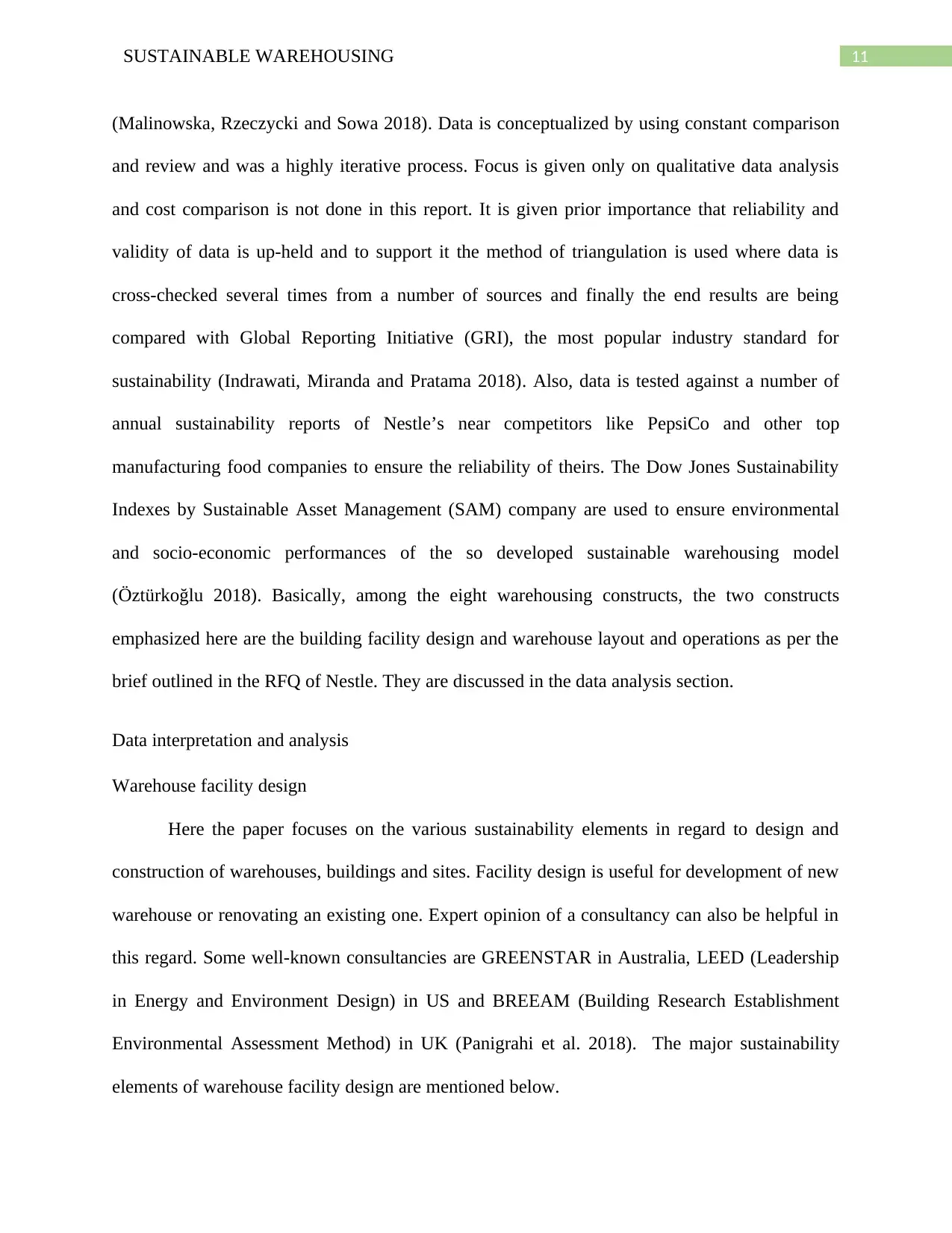
11SUSTAINABLE WAREHOUSING
(Malinowska, Rzeczycki and Sowa 2018). Data is conceptualized by using constant comparison
and review and was a highly iterative process. Focus is given only on qualitative data analysis
and cost comparison is not done in this report. It is given prior importance that reliability and
validity of data is up-held and to support it the method of triangulation is used where data is
cross-checked several times from a number of sources and finally the end results are being
compared with Global Reporting Initiative (GRI), the most popular industry standard for
sustainability (Indrawati, Miranda and Pratama 2018). Also, data is tested against a number of
annual sustainability reports of Nestle’s near competitors like PepsiCo and other top
manufacturing food companies to ensure the reliability of theirs. The Dow Jones Sustainability
Indexes by Sustainable Asset Management (SAM) company are used to ensure environmental
and socio-economic performances of the so developed sustainable warehousing model
(Öztürkoğlu 2018). Basically, among the eight warehousing constructs, the two constructs
emphasized here are the building facility design and warehouse layout and operations as per the
brief outlined in the RFQ of Nestle. They are discussed in the data analysis section.
Data interpretation and analysis
Warehouse facility design
Here the paper focuses on the various sustainability elements in regard to design and
construction of warehouses, buildings and sites. Facility design is useful for development of new
warehouse or renovating an existing one. Expert opinion of a consultancy can also be helpful in
this regard. Some well-known consultancies are GREENSTAR in Australia, LEED (Leadership
in Energy and Environment Design) in US and BREEAM (Building Research Establishment
Environmental Assessment Method) in UK (Panigrahi et al. 2018). The major sustainability
elements of warehouse facility design are mentioned below.
(Malinowska, Rzeczycki and Sowa 2018). Data is conceptualized by using constant comparison
and review and was a highly iterative process. Focus is given only on qualitative data analysis
and cost comparison is not done in this report. It is given prior importance that reliability and
validity of data is up-held and to support it the method of triangulation is used where data is
cross-checked several times from a number of sources and finally the end results are being
compared with Global Reporting Initiative (GRI), the most popular industry standard for
sustainability (Indrawati, Miranda and Pratama 2018). Also, data is tested against a number of
annual sustainability reports of Nestle’s near competitors like PepsiCo and other top
manufacturing food companies to ensure the reliability of theirs. The Dow Jones Sustainability
Indexes by Sustainable Asset Management (SAM) company are used to ensure environmental
and socio-economic performances of the so developed sustainable warehousing model
(Öztürkoğlu 2018). Basically, among the eight warehousing constructs, the two constructs
emphasized here are the building facility design and warehouse layout and operations as per the
brief outlined in the RFQ of Nestle. They are discussed in the data analysis section.
Data interpretation and analysis
Warehouse facility design
Here the paper focuses on the various sustainability elements in regard to design and
construction of warehouses, buildings and sites. Facility design is useful for development of new
warehouse or renovating an existing one. Expert opinion of a consultancy can also be helpful in
this regard. Some well-known consultancies are GREENSTAR in Australia, LEED (Leadership
in Energy and Environment Design) in US and BREEAM (Building Research Establishment
Environmental Assessment Method) in UK (Panigrahi et al. 2018). The major sustainability
elements of warehouse facility design are mentioned below.
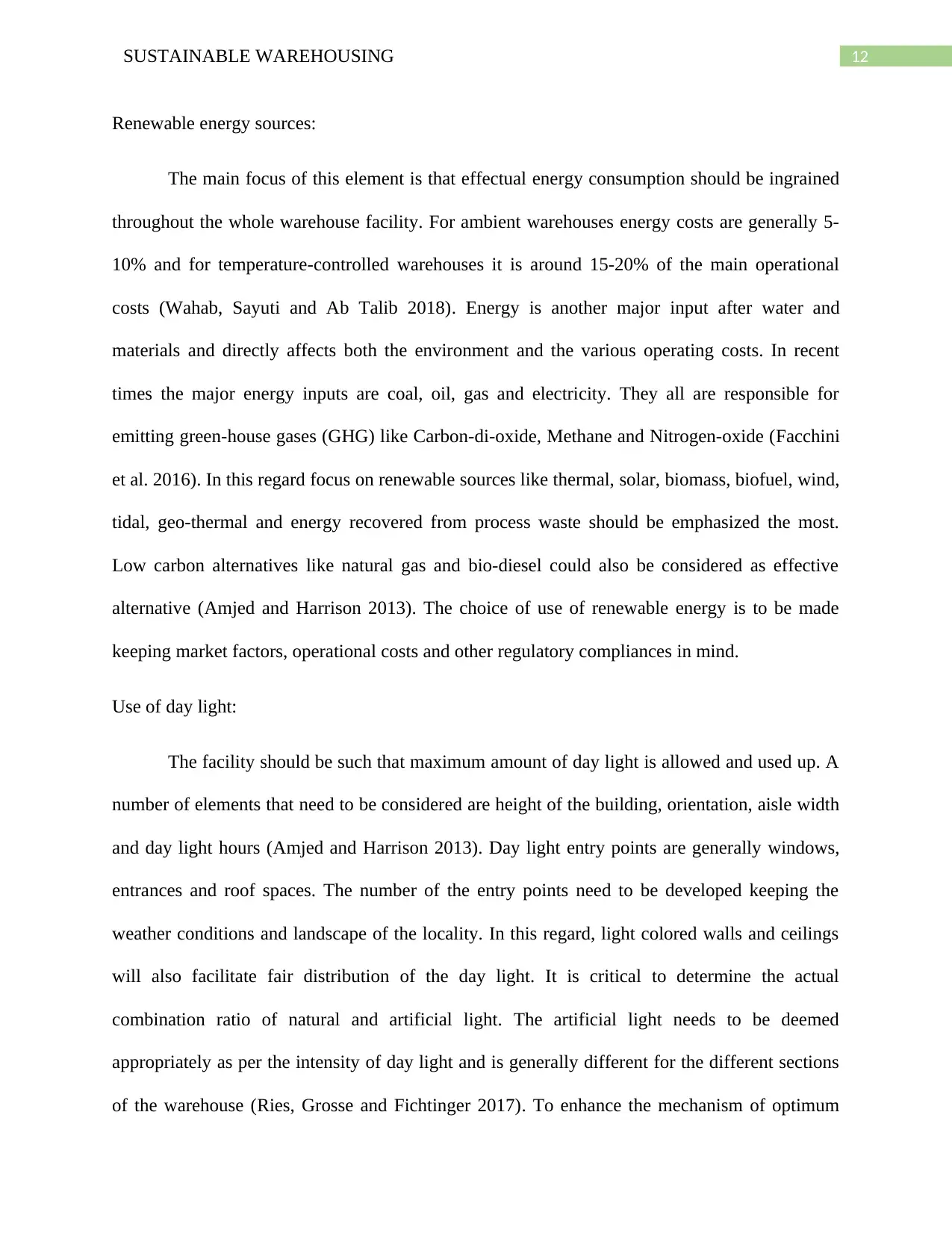
12SUSTAINABLE WAREHOUSING
Renewable energy sources:
The main focus of this element is that effectual energy consumption should be ingrained
throughout the whole warehouse facility. For ambient warehouses energy costs are generally 5-
10% and for temperature-controlled warehouses it is around 15-20% of the main operational
costs (Wahab, Sayuti and Ab Talib 2018). Energy is another major input after water and
materials and directly affects both the environment and the various operating costs. In recent
times the major energy inputs are coal, oil, gas and electricity. They all are responsible for
emitting green-house gases (GHG) like Carbon-di-oxide, Methane and Nitrogen-oxide (Facchini
et al. 2016). In this regard focus on renewable sources like thermal, solar, biomass, biofuel, wind,
tidal, geo-thermal and energy recovered from process waste should be emphasized the most.
Low carbon alternatives like natural gas and bio-diesel could also be considered as effective
alternative (Amjed and Harrison 2013). The choice of use of renewable energy is to be made
keeping market factors, operational costs and other regulatory compliances in mind.
Use of day light:
The facility should be such that maximum amount of day light is allowed and used up. A
number of elements that need to be considered are height of the building, orientation, aisle width
and day light hours (Amjed and Harrison 2013). Day light entry points are generally windows,
entrances and roof spaces. The number of the entry points need to be developed keeping the
weather conditions and landscape of the locality. In this regard, light colored walls and ceilings
will also facilitate fair distribution of the day light. It is critical to determine the actual
combination ratio of natural and artificial light. The artificial light needs to be deemed
appropriately as per the intensity of day light and is generally different for the different sections
of the warehouse (Ries, Grosse and Fichtinger 2017). To enhance the mechanism of optimum
Renewable energy sources:
The main focus of this element is that effectual energy consumption should be ingrained
throughout the whole warehouse facility. For ambient warehouses energy costs are generally 5-
10% and for temperature-controlled warehouses it is around 15-20% of the main operational
costs (Wahab, Sayuti and Ab Talib 2018). Energy is another major input after water and
materials and directly affects both the environment and the various operating costs. In recent
times the major energy inputs are coal, oil, gas and electricity. They all are responsible for
emitting green-house gases (GHG) like Carbon-di-oxide, Methane and Nitrogen-oxide (Facchini
et al. 2016). In this regard focus on renewable sources like thermal, solar, biomass, biofuel, wind,
tidal, geo-thermal and energy recovered from process waste should be emphasized the most.
Low carbon alternatives like natural gas and bio-diesel could also be considered as effective
alternative (Amjed and Harrison 2013). The choice of use of renewable energy is to be made
keeping market factors, operational costs and other regulatory compliances in mind.
Use of day light:
The facility should be such that maximum amount of day light is allowed and used up. A
number of elements that need to be considered are height of the building, orientation, aisle width
and day light hours (Amjed and Harrison 2013). Day light entry points are generally windows,
entrances and roof spaces. The number of the entry points need to be developed keeping the
weather conditions and landscape of the locality. In this regard, light colored walls and ceilings
will also facilitate fair distribution of the day light. It is critical to determine the actual
combination ratio of natural and artificial light. The artificial light needs to be deemed
appropriately as per the intensity of day light and is generally different for the different sections
of the warehouse (Ries, Grosse and Fichtinger 2017). To enhance the mechanism of optimum
⊘ This is a preview!⊘
Do you want full access?
Subscribe today to unlock all pages.

Trusted by 1+ million students worldwide
1 out of 26
Your All-in-One AI-Powered Toolkit for Academic Success.
+13062052269
info@desklib.com
Available 24*7 on WhatsApp / Email
![[object Object]](/_next/static/media/star-bottom.7253800d.svg)
Unlock your academic potential
Copyright © 2020–2025 A2Z Services. All Rights Reserved. Developed and managed by ZUCOL.


